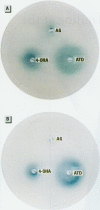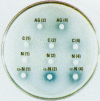Abstract
Endocrine disruptors are hormone mimics that modify hormonal action in humans and animals. It is thought that some endocrine disruptors modify estrogen and androgen action in humans and animals by suppressing aromatase activity. Aromatase cytochrome P450 is the key enzyme that converts C19 androgens to aromatic C18 estrogenic steroids. We have developed a novel aromatase inhibitor screening method that allows us to identify antiaromatase activity of various environmental chemicals. The screen was developed by coexpressing the human aromatase and the mouse androgen receptor in yeast cells, which carry the androgen-responsive ss-galactosidase reporter plasmid. Functional expression of aromatase in yeast has been demonstrated using the [3H]-water release assay with intact cells as well as with yeast microsomes. The aromatase activity could be blocked by known aromatase inhibitors such as aminoglutethimide (AG). Yeast-produced androgen receptors were able to transactivate a yeast basal promoter linked to an androgen-responsive element in response to androgens. The resultant triple yeast transformant responded to the treatment of testosterone, androstenedione, or 5 alpha-dihydrotestosterone (5 alpha-DHT). In the absence of the aromatase inhibitor AG, transcriptional activation was observed only for the nonaromatizable androgen 5 alpha-DHT. However, the two aromatizable androgens (testosterone and androstenedione) induced the reporter activity in the presence of AG. Using this yeast-based assay, we confirmed that two flavones, chrysin and alpha-naphtholflavone, are inhibitors of aromatase. Thus, this yeast system allows us to develop a high-throughput screening method, without using radioactive substrate, to identify aromatase inhibitors as well as new ligands (nonaromatizable androgen mimics) for the androgen receptors. In addition, this screening method also allows us to distinguish nonandrogenic aromatase inhibitors from inhibitors with androgenic activity. This yeast screening method will be useful to screen environmental chemicals for their antiaromatase activity and for their interaction with androgen receptor.
Full text
PDF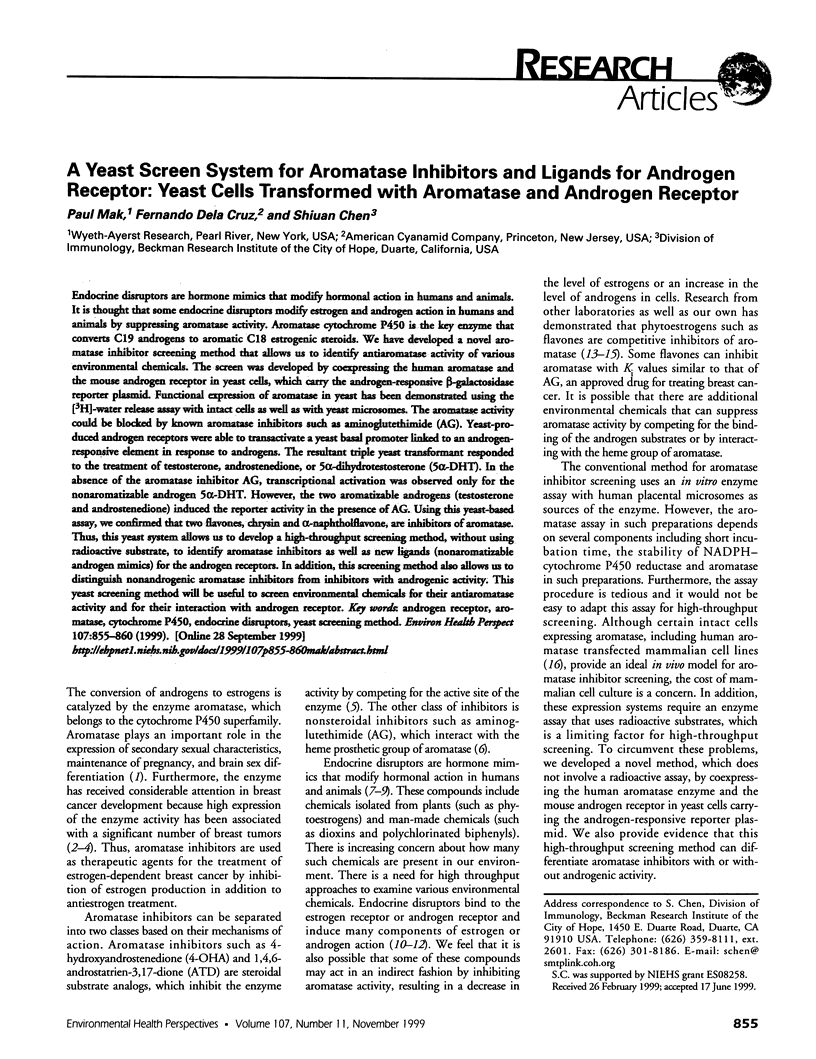
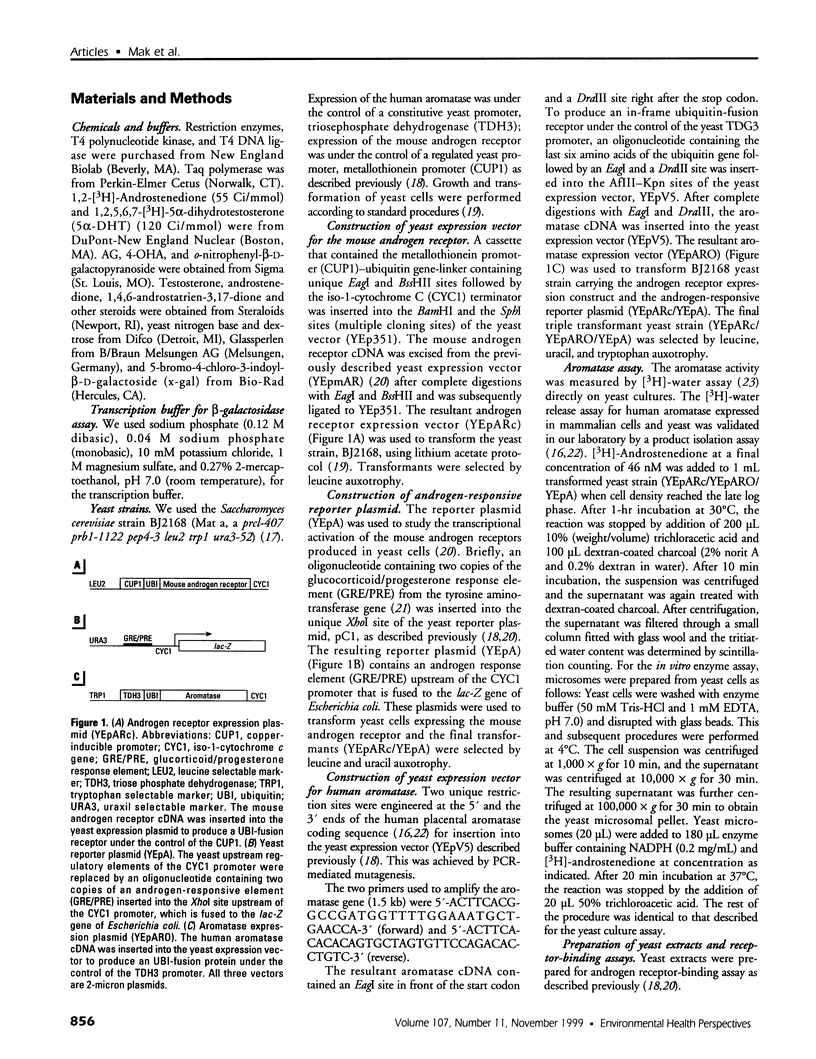
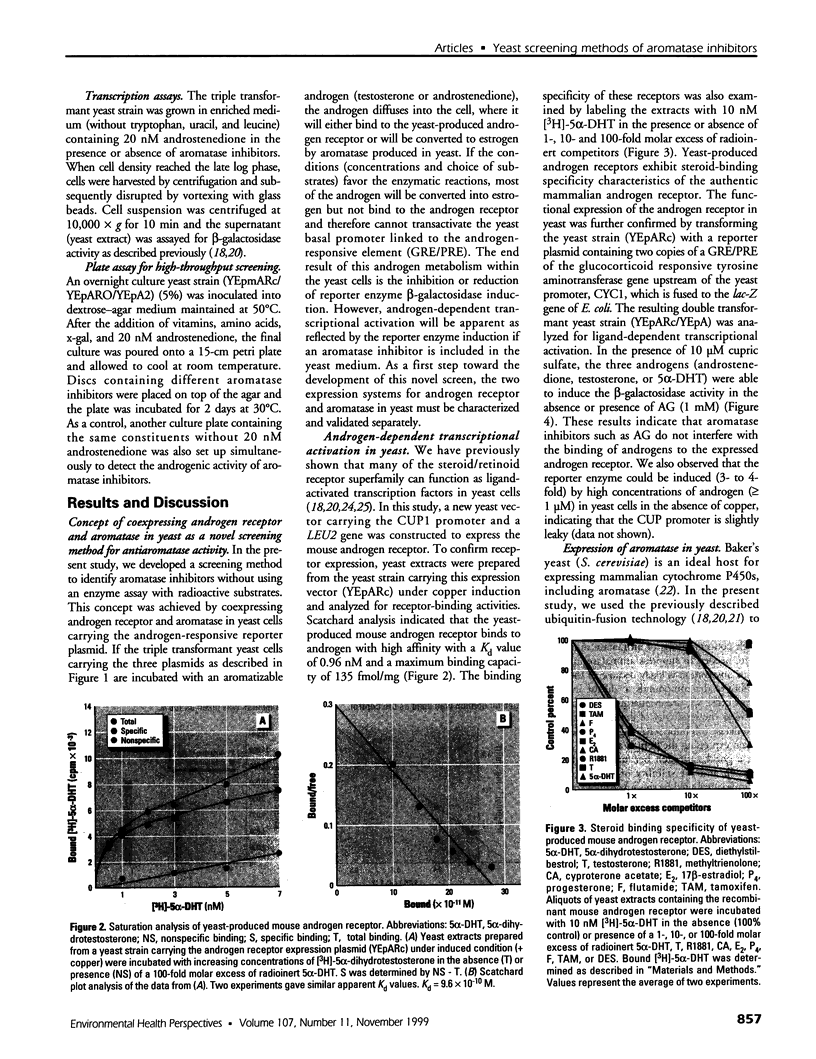
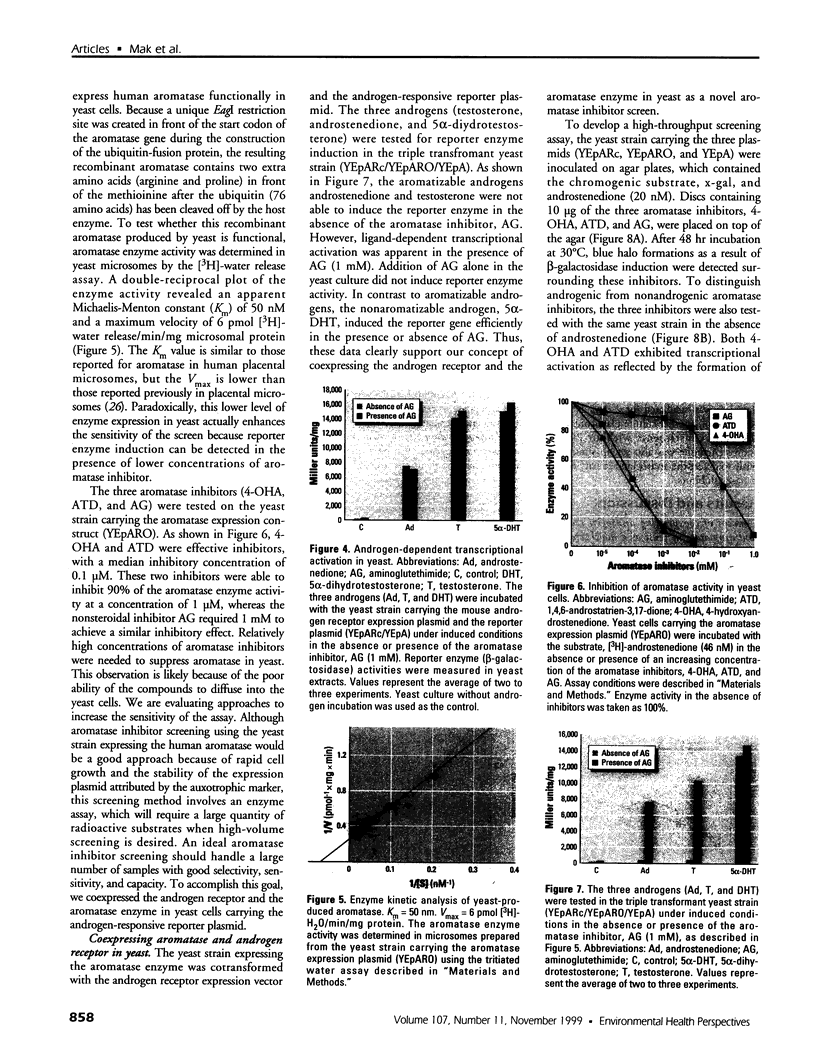
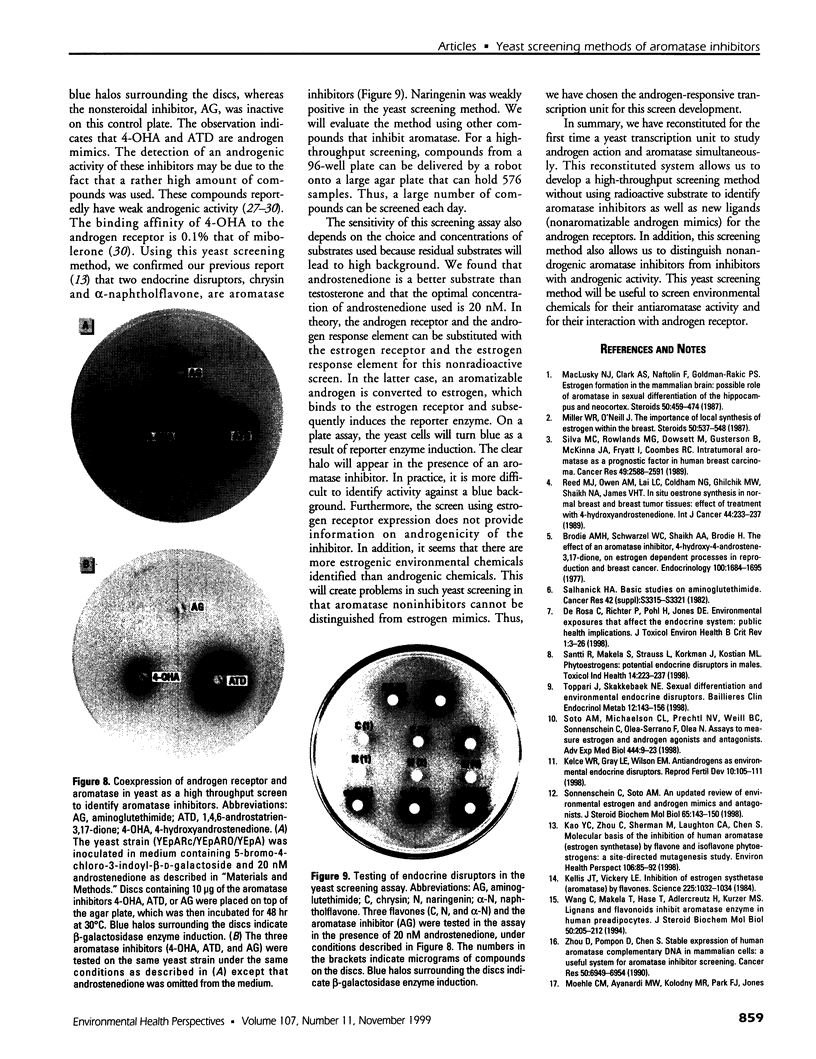

Images in this article
Selected References
These references are in PubMed. This may not be the complete list of references from this article.
- Bagchi M. K., Elliston J. F., Tsai S. Y., Edwards D. P., Tsai M. J., O'Malley B. W. Steroid hormone-dependent interaction of human progesterone receptor with its target enhancer element. Mol Endocrinol. 1988 Dec;2(12):1221–1229. doi: 10.1210/mend-2-12-1221. [DOI] [PubMed] [Google Scholar]
- Brodie A. M., Schwarzel W. C., Shaikh A. A., Brodie H. J. The effect of an aromatase inhibitor, 4-hydroxy-4-androstene-3,17-dione, on estrogen-dependent processes in reproduction and breast cancer. Endocrinology. 1977 Jun;100(6):1684–1695. doi: 10.1210/endo-100-6-1684. [DOI] [PubMed] [Google Scholar]
- Brodie A. Aromatase and its inhibitors--an overview. J Steroid Biochem Mol Biol. 1991;40(1-3):255–261. doi: 10.1016/0960-0760(91)90190-g. [DOI] [PubMed] [Google Scholar]
- Davies J. H., Shearer R. J., Rowlands M. G., Poon G. K., Houghton J., Jarman M., Dowsett M. Effects of 4-hydroxyandrost-4-ene-3,17-dione and its metabolites on 5 alpha-reductase activity and the androgen receptor. J Enzyme Inhib. 1992;6(2):141–147. doi: 10.3109/14756369209040745. [DOI] [PubMed] [Google Scholar]
- DeRosa C., Richter P., Pohl H., Jones D. E. Environmental exposures that affect the endocrine system: public health implications. J Toxicol Environ Health B Crit Rev. 1998 Jan-Mar;1(1):3–26. doi: 10.1080/10937409809524541. [DOI] [PubMed] [Google Scholar]
- Dowsett M. Clinical development of aromatase inhibitors for the treatment of breast and prostate cancer. J Steroid Biochem Mol Biol. 1990 Dec 20;37(6):1037–1041. doi: 10.1016/0960-0760(90)90462-t. [DOI] [PubMed] [Google Scholar]
- Dowsett M., Coombes R. C. Second generation aromatase inhibitor--4-hydroxyandrostenedione. Breast Cancer Res Treat. 1994;30(1):81–87. doi: 10.1007/BF00682742. [DOI] [PubMed] [Google Scholar]
- Kao Y. C., Higashiyama T., Yarborough C., Osawa Y., Chen S. Functional characterization of 102-amino acid-deleted form of human aromatase (delta102-aromatase). Steroids. 1999 Jun;64(6):422–429. doi: 10.1016/s0039-128x(99)00019-7. [DOI] [PubMed] [Google Scholar]
- Kao Y. C., Zhou C., Sherman M., Laughton C. A., Chen S. Molecular basis of the inhibition of human aromatase (estrogen synthetase) by flavone and isoflavone phytoestrogens: A site-directed mutagenesis study. Environ Health Perspect. 1998 Feb;106(2):85–92. doi: 10.1289/ehp.9810685. [DOI] [PMC free article] [PubMed] [Google Scholar]
- Kelce W. R., Gray L. E., Wilson E. M. Antiandrogens as environmental endocrine disruptors. Reprod Fertil Dev. 1998;10(1):105–111. doi: 10.1071/r98051. [DOI] [PubMed] [Google Scholar]
- Kellis J. T., Jr, Vickery L. E. Inhibition of human estrogen synthetase (aromatase) by flavones. Science. 1984 Sep 7;225(4666):1032–1034. doi: 10.1126/science.6474163. [DOI] [PubMed] [Google Scholar]
- MacLusky N. J., Clark A. S., Naftolin F., Goldman-Rakic P. S. Estrogen formation in the mammalian brain: possible role of aromatase in sexual differentiation of the hippocampus and neocortex. Steroids. 1987 Oct-Dec;50(4-6):459–474. doi: 10.1016/0039-128x(87)90032-8. [DOI] [PubMed] [Google Scholar]
- Mak P., Fuernkranz H. A., Ge R., Karathanasis S. K. Retinoid X receptor homodimers function as transcriptional activators in yeast. Gene. 1994 Jul 22;145(1):129–133. doi: 10.1016/0378-1119(94)90335-2. [DOI] [PubMed] [Google Scholar]
- Mak P., McDonnell D. P., Weigel N. L., Schrader W. T., O'Malley B. W. Expression of functional chicken oviduct progesterone receptors in yeast (Saccharomyces cerevisiae). J Biol Chem. 1989 Dec 25;264(36):21613–21618. [PubMed] [Google Scholar]
- Mak P., Young C. Y., Tindall D. J. A novel yeast expression system to study androgen action. Recent Prog Horm Res. 1994;49:347–352. doi: 10.1016/b978-0-12-571149-4.50023-4. [DOI] [PubMed] [Google Scholar]
- Miller W. R., O'Neill J. The importance of local synthesis of estrogen within the breast. Steroids. 1987 Oct-Dec;50(4-6):537–548. doi: 10.1016/0039-128x(87)90037-7. [DOI] [PubMed] [Google Scholar]
- Moehle C. M., Aynardi M. W., Kolodny M. R., Park F. J., Jones E. W. Protease B of Saccharomyces cerevisiae: isolation and regulation of the PRB1 structural gene. Genetics. 1987 Feb;115(2):255–263. doi: 10.1093/genetics/115.2.255. [DOI] [PMC free article] [PubMed] [Google Scholar]
- Pompon D., Liu R. Y., Besman M. J., Wang P. L., Shively J. E., Chen S. Expression of human placental aromatase in Saccharomyces cerevisiae. Mol Endocrinol. 1989 Sep;3(9):1477–1487. doi: 10.1210/mend-3-9-1477. [DOI] [PubMed] [Google Scholar]
- Reed M. J., Owen A. M., Lai L. C., Coldham N. G., Ghilchik M. W., Shaikh N. A., James V. H. In situ oestrone synthesis in normal breast and breast tumour tissues: effect of treatment with 4-hydroxyandrostenedione. Int J Cancer. 1989 Aug 15;44(2):233–237. doi: 10.1002/ijc.2910440208. [DOI] [PubMed] [Google Scholar]
- Salerno A. J., He Z., Goos-Nilsson A., Ahola H., Mak P. Differential transcriptional regulation of the apoAI gene by retinoic acid receptor homo- and heterodimers in yeast. Nucleic Acids Res. 1996 Feb 15;24(4):566–572. doi: 10.1093/nar/24.4.566. [DOI] [PMC free article] [PubMed] [Google Scholar]
- Santti R., Mäkelä S., Strauss L., Korkman J., Kostian M. L. Phytoestrogens: potential endocrine disruptors in males. Toxicol Ind Health. 1998 Jan-Apr;14(1-2):223–237. doi: 10.1177/074823379801400114. [DOI] [PubMed] [Google Scholar]
- Silva M. C., Rowlands M. G., Dowsett M., Gusterson B., McKinna J. A., Fryatt I., Coombes R. C. Intratumoral aromatase as a prognostic factor in human breast carcinoma. Cancer Res. 1989 May 15;49(10):2588–2591. [PubMed] [Google Scholar]
- Sonnenschein C., Soto A. M. An updated review of environmental estrogen and androgen mimics and antagonists. J Steroid Biochem Mol Biol. 1998 Apr;65(1-6):143–150. doi: 10.1016/s0960-0760(98)00027-2. [DOI] [PubMed] [Google Scholar]
- Soto A. M., Michaelson C. L., Prechtl N. V., Weill B. C., Sonnenschein C., Olea-Serrano F., Olea N. Assays to measure estrogen and androgen agonists and antagonists. Adv Exp Med Biol. 1998;444:9–28. doi: 10.1007/978-1-4899-0089-0_3. [DOI] [PubMed] [Google Scholar]
- Thompson E. A., Jr, Siiteri P. K. Utilization of oxygen and reduced nicotinamide adenine dinucleotide phosphate by human placental microsomes during aromatization of androstenedione. J Biol Chem. 1974 Sep 10;249(17):5364–5372. [PubMed] [Google Scholar]
- Toppari J., Skakkebaek N. E. Sexual differentiation and environmental endocrine disrupters. Baillieres Clin Endocrinol Metab. 1998 Apr;12(1):143–156. doi: 10.1016/s0950-351x(98)80529-6. [DOI] [PubMed] [Google Scholar]
- Wang C., Mäkelä T., Hase T., Adlercreutz H., Kurzer M. S. Lignans and flavonoids inhibit aromatase enzyme in human preadipocytes. J Steroid Biochem Mol Biol. 1994 Aug;50(3-4):205–212. doi: 10.1016/0960-0760(94)90030-2. [DOI] [PubMed] [Google Scholar]
- Zhou D. J., Pompon D., Chen S. A. Stable expression of human aromatase complementary DNA in mammalian cells: a useful system for aromatase inhibitor screening. Cancer Res. 1990 Nov 1;50(21):6949–6954. [PubMed] [Google Scholar]









